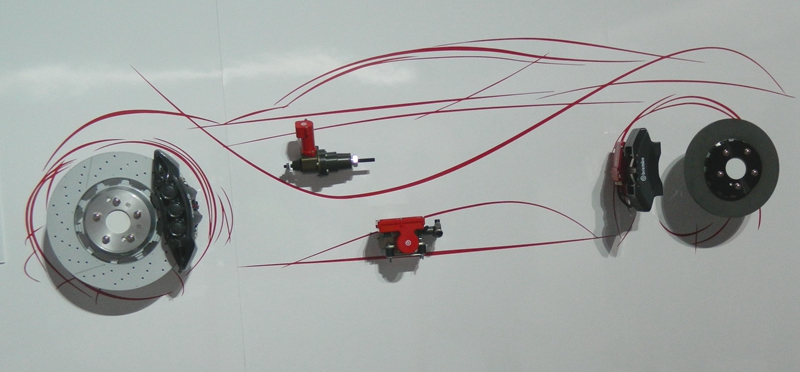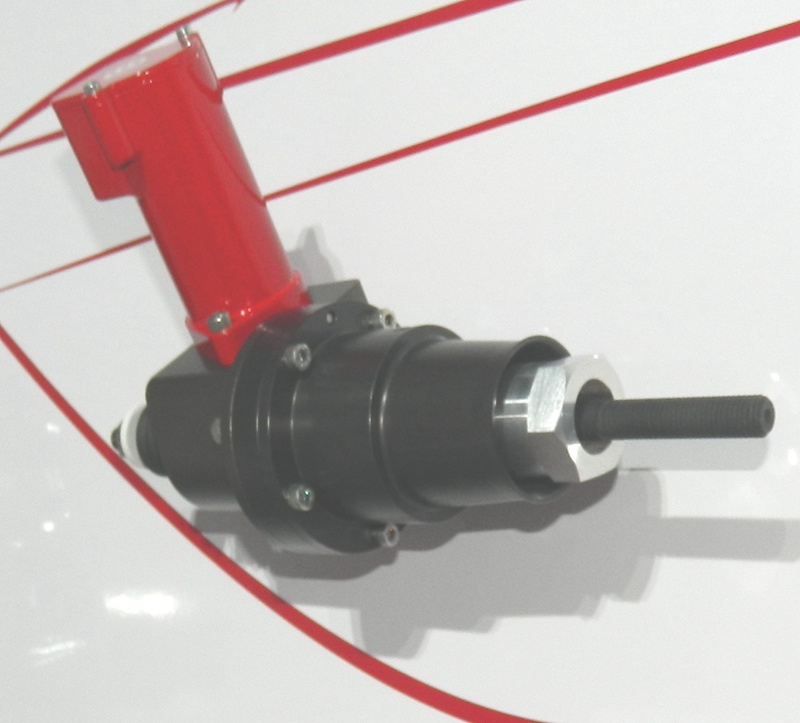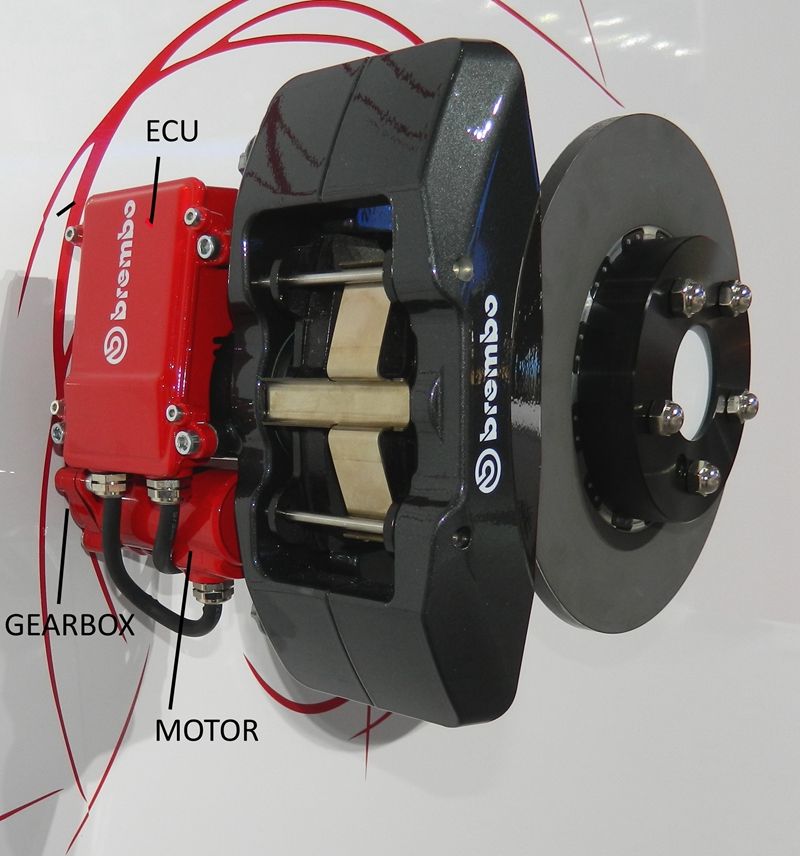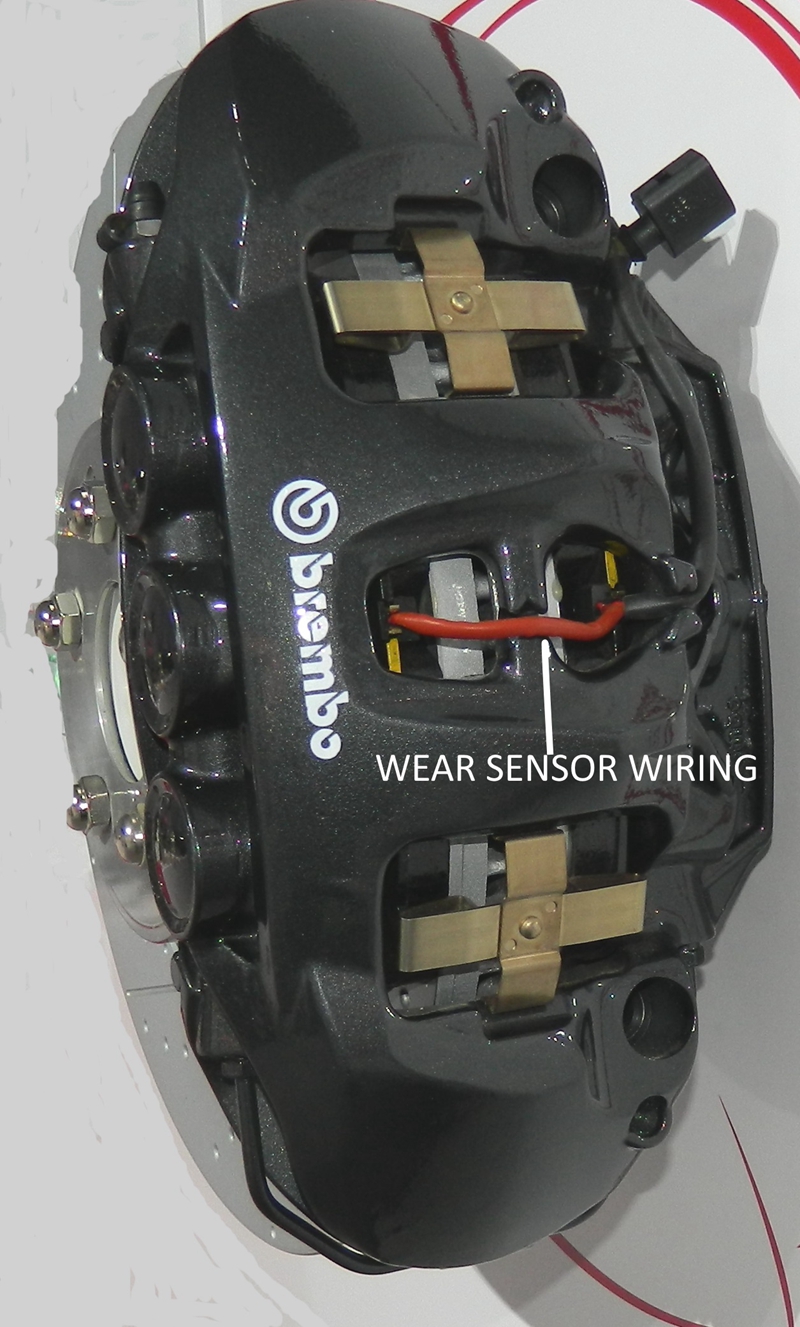 布雷博的线传操控制动系统包括机电踏板传感器(中上)和内置电机/泵送系统的ECU单元(中下),其中电机/泵总成也会向6活塞前制动卡钳输送液压信号。
布雷博的线传操控制动系统包括机电踏板传感器(中上)和内置电机/泵送系统的ECU单元(中下),其中电机/泵总成也会向6活塞前制动卡钳输送液压信号。 踏板传感器可以将司机脚下的制动信号传送给ECU单元。
踏板传感器可以将司机脚下的制动信号传送给ECU单元。 ECU总成可以与压力传感器协同工作,确认电池系统的电荷状态,并操作电机和泵送系统,向6活塞前制动卡钳输送液压信号。
ECU总成可以与压力传感器协同工作,确认电池系统的电荷状态,并操作电机和泵送系统,向6活塞前制动卡钳输送液压信号。 布雷博的后方制动系统为纯电动设计,其电机可通过变速箱促动浮动制动卡钳。该制动系统也能作为停车制动设备使用。
布雷博的后方制动系统为纯电动设计,其电机可通过变速箱促动浮动制动卡钳。该制动系统也能作为停车制动设备使用。  系统的前制动卡钳拥有6个活塞,可为大型车辆提供充足的制动力。此外,系统的制动衬面还配备有磨损传感器。
系统的前制动卡钳拥有6个活塞,可为大型车辆提供充足的制动力。此外,系统的制动衬面还配备有磨损传感器。
虽然在汽车工程师眼中,电动车轮制动系统(electric wheel-braking system)拥有巨大的潜力,但目前尚无任何量产车型搭配了此类系统。虽然该系统本身就可以提高制动的精确度,但更重要的是,线传操控制动(brake-by-wire)系统不但有助于应对政府日趋严苛的强制性节能减排规定,而且还能更加轻松地整合到半自动和自动驾驶汽车之中。
顶级意大利制动系统供应商布雷博(Brembo)在北美国际车展(简称NAIAS展)就发布了这样一款已经与众多汽车生产商见过面的线传操控制动系统。布雷博对电动基础制动的研究已经进行了大约15年,而且正如公司首席技术官Georgio Ascanelli告诉《汽车工程杂志》(Automotive Engineering)的那样,这项技术未来仍拥有相当大的进步空间。
Ascanelli指出,到目前为止,其他现有的电动制动系统都存在一定程度的不耐用或不可靠问题。为了应对这一问题,布雷博的设计采用了一个中央电子控制单元(简称ECU),及四个分布在角落的独立制动单元。
“我们的系统可以在另外四个独立单元中任何一个出现故障时继续工作。”他表示,这个系统甚至可以在多个部件同时出现故障的情况下正常工作。公司还将为电动制动系统配备了独立的供电系统。只要系统的所有故障模态分析结果对安全相关系统而言均属正常,电动制动系统甚至可以提供自动驾驶级别的置信水平。
Ascanelli表示,布雷博在一辆跑车上安装了自己的线传操控系统,并对其进行测试,目前已经累计了超过50万公里的安全行驶里程。公司还在打造一款展示车,从而提供更多可以说服厂商的证据。他表示,从技术层面而言,这种系统可在2020年前做好量产准备,但的确仍有部分厂商认为此类创新具有很高的风险。
传感器刹车踏板
系统的“刹车踏板”为一款弹簧加载机电传感器(未来有再设计或精简的潜力),可向ECU单元发送成比例的信号。该模块可以确认电池系统的电荷状态,并操作电机/泵向6活塞前制动卡钳输送液压信号。这不就是一个电动液压系统吗?对于较大车型来说,的确是这样。采用这种设计,是因为现有的分火头和卡钳无法提供纯电动系统所需的轮间空间。
Ascanelli解释说,布雷博的全电动系统采用了基本架构,适用于雷诺(Renault)的Twingo等小型车。未来随着产品的设计发展和持续优化,全电动制动系统也有望现身于一些较大车型。
目前,布雷博线传操控制动系统的响应时间仅为90ms,而搭配助力器和防死锁促动器的传统液压制动系统则需300ms。他指出,该制动系统的响应速度更快,可以为基本的碰撞减缓系统(collision-mitigation system)和更高要求的自动驾驶系统(autonomous driving system)提供更加优化的自动制动支持。
车辆的后方制动系统采用了一台电机和一台变速箱,属于纯机电系统,本身也可以发挥停车制动的功能。
可伸缩活塞
虽然系统的前方制动系统的确采用了液压设计,但由于其电路完全受到电机和ECU单元的控制,系统的纯电气操作保证了前后活塞可以进行快速自由伸缩。Ascanelli表示,活塞进行伸缩的最小间隙为0.2毫米,完全可以消除分火头摩擦面上的阻力,在城市工况下可将汽油发动机的燃油经济性提高10%。
此外,电动制动系统的精准控制还允许电动车或混动车进行精确校准,提高制动动能的回收效率,从而提升车辆燃油经济性。他补充说,减少阻力和优化制动动能回收都能降低二氧化碳的排放。
电动制动系统虽然增加了一些零部件,却省去了传统制动系统中必不可少的制动助力器和防死锁促动器。Ascanelli表示,因此,相信电动制动系统的总重量将低于传统制动系统。他承认,在最初阶段,电动制动系统必须与传统制动系统打价格战,即使这种系统本身的成本更高。
不过,他认为供应商可以通过提高产量,并积极利用市场反馈修正新设计(特别是与安全有关的新设计)中经常出现的过度设计问题,最终“取得一个市场可接受的价格”。
作者:Paul Weissler
来源:SAE 《汽车工程杂志》
翻译:SAE 上海办公室
Brembo brake-by-wire will be production-ready before 2020
The potential market for an electric wheel-braking system is apparent to automotive engineers, but none is now in vehicle production. Such a system adds a level of precision to braking itself, but even more important, brake-by-wire fits into the engineering picture to meet the low-emissions/higher fuel economy mandates in government regulation. And it could be easier to integrate into semi-autonomous and autonomous operation.
Premium braking system supplier Brembo, in a display at NAIAS, featured a system it already has shown to many car makers. Electric foundation braking has been in development at Brembo for some 15 years, and as Chief Technical Officer Georgio Ascanelli told Automotive Engineering, it has potential for considerable further development.
Other electric braking systems developed to date have posed durability/reliability questions, Ascanelli noted. For contrast, he pointed to the Brembo design's use of one central ECU and four corner modules.
"It could operate with a failure of the other four," he said, so there is coverage for even simultaneous multiple failures. Some separation of the battery supply system also would be needed to fit into this picture. With all the failure mode analysis normal for safety-related systems, there should be an overall confidence level even for autonomous driving.
The Brembo test system has accumulated over 500,000 km (300,000 mi) of safe operation on a sports car, Ascanelli said, and the company is completing a demonstrator to provide further evidence to vehicle OEMs. Technically, he expects the system to be ready for use well before 2020, while admitting that some OEMs consider such innovations to be risky.
Brake pedal just a sensor
The system begins at the "brake pedal," in this case a spring-loaded electro-mechanical sensor (with potential for redesign/downsizing) that produces a proportional signal to the ECU. This module both confirms battery system state of charge and operates a pump/motor assembly to produce a hydraulic output to the front caliper, a six-piston unit. Doesn't this make it an electro-hydraulic system? For larger cars, yes, because the design of the present rotor and caliper do not provide the wheel space needed for a purely electrical system.
Using the basic architecture, an all-electric system could be produced for small cars, such as the Renault Twingo, Ascanelli explained. And with product redesign and continuous improvement, the potential of all-electric foundation brakes for larger models can be anticipated.
At its present state, the system response time is just 90 ms, vs. 300 ms on a conventional all-hydraulic braking system with booster and anti-lock braking actuator. The fast response time means the system can provide auto-braking improvements for both basic collision-mitigation systems and the more demanding requirements of autonomous driving, he noted.
Because the rear system is "dry" (i.e., fully electro-mechanical), using a motor and gearbox, it lends itself also to serving as the parking brake.
Pistons positively retracted
Although the system does use hydraulics for the front brakes, the overall electrical operation permits quickly and positively retracting pistons front and rear because the circuits are being controlled with motors and an ECU. The retracted piston clearance, 0.2 mm (.001-in) or more totally eliminates piston drag on the rotor friction surfaces, Ascanelli said, which he claims accounts for about 10% of fuel consumption in city operation with a gasoline engine.
The precise control of an electric braking system also permits calibration to improve the efficiency of regenerative braking on electric vehicles and hybrids, so it boosts fuel economy for these cars. Those two factors—no drag and improved regen braking—therefore lower carbon dioxide emissions, he added.
An electric braking system does add components, but in addition to a simpler parking brake it eliminates the brake booster and anti-lock brake actuator. So Ascanelli said he believes the overall system can be lighter than a conventional one. The initial selling price to OEMs would have to be competitive with the conventional systems in use, he admitted, even if it costs suppliers more.
However, he believes suppliers can "get to a comparable price" by increasing volume and using feedback from the market to correct the natural over-engineering that is typical of a new design, particularly one so safety-related.
Author: Paul Weissler
Source: SAE Automotive Engineering Magazine
等级
打分
- 2分
- 4分
- 6分
- 8分
- 10分
平均分
- 作者:Paul Weissler
- 行业:汽车
- 主题:噪声、振动与声振粗糙度质量、可靠性与耐久性安全性人体工程学/人因工程学车辆底盘与飞机起落架电气电子与航空电子测试与检验
